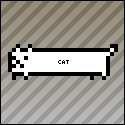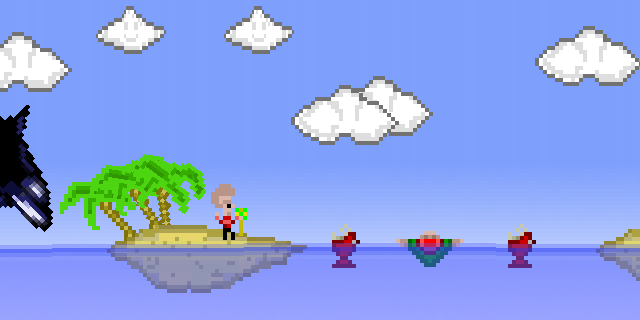|
    video! http://heeen.de/proj/refract.avi
|
|
|
|

|
| # ¿ Apr 27, 2024 11:49 |
|
Dr. Stupid posted:Is this you own algorithm or something you "just" implemented? Cause it looks pretty drat nice. It's actually not so big of a deal, just raycasting a refracted viewing vector in the fragment shader, which fragments can see which part of the underwater scene is the tricky part. The idea is from me and my CG professor for what you could call bachelor's thesis.
|
|
|
|
Zagrod posted:Are the broken walls modelled or do you use some kind of procedural shader to generate the plaster?
|
|
|
|
Nomikos posted:I got sick of how all available music-visualization plugins had really poor spectrograms, so I made my own.
|
|
|
|
Nomikos posted:Thanks for the suggestions about glDrawPixel alternatives. From my initial look at the GLSL tutorials, synchronizing the scrolling action between my program and the shader sounds difficult so I'll probably try the enormous-stream-of-vertices idea first. The way I'd implement this is: Render into a texture, using an orthographic projection: * a thin quad with the new column of data all the way on the left * next to it, filling the rest of the frustum a quad with the old data, change the texture coordinates on the right to cut off the oldest column of data render to your main view: * a quad with the texture created above You don't even need a fragment shader. Make sure to not use texutre filtering in the first pass.
|
|
|
|
    A little experiment I'm building, app engine based.
|
|
|
|
I'm trying to find the quad that covers a given triangle on the screen, as in the minimum and maximum screen coordinates of all three triangle points. I'm calculating the normalized device coordinates of my points and take the minimum and maximum accordingly, however I have problems with points that lie behind the camera / the near plane. Since they get a negative .w value, their x and y coordinates get flipped and somehow I can't seem to get it right. However simply saying that their x- y- coordinates lie on the edge if their w component is negative has so far not proven successful. code:
|
|
|
|
I think that dialog box should be painted blue
|
|
|
|
RonaldMcDonald posted:I just got done writing a little application to scan our file server for screwed up permissions. We had a lot of issues with directories that had permissions that made no sense so I wanted to clean up our server. Since I didn't find an application that helped much, I wrote one myself. Took maybe 100 hours.
|
|
|
|
Iniluki posted:No where near as good as some of the stuff i've seen you guys post. But it's entertaining the hell out of me at the moment. This is going to bite you in the rear end when it finds swear words when there were none intended. What if grandma Smith is missing her pussycat?
|
|
|
|
Stramit posted:Here are two images i made in one of my old raytracers. I'm rejigging it to be actually nice and incorporate all the new coding stuff / performance i know since I wrote it originally (about 2 years ago).
|
|
|
|

|
|
|
|
A vintage terminal shader I'm working on: http://heeen.de/proj/screenshader.avi edit: youtube: http://www.youtube.com/watch?v=d5uf0T8Yk74 heeen fucked around with this message at 21:54 on Feb 6, 2009 |
|
|
|
http://heeen.de/proj/picking.avi
|
|
|
|
 Subdivision surfaces!
|
|
|
|
Hubis posted:I hear the performance overhead for CUDA/GL interop is pretty bad, C/D? Cuda: Steps: 4 pre kernel 0.156981ms cuda 45.9069ms render 1.42665ms FPS: 21.0568 quads: 331008 Cuda Emulation: Steps: 4 pre kernel 16.1864ms cuda 1684.88ms render 1.33251ms FPS: 0.587405 quads: 331008 Geforce 8800 GTS 320MB
|
|
|
|
Extending on my previous work, now refraction + caustics: http://heeen.de/proj/refractioncaustic.avi
|
|
|
|
akadajet posted:Are the caustics just random, or are they actually calculated based on the surface normals? The caustics, as is what the camera sees, are raycasted in fragment shaders. Jo posted:That's very much a thing of beauty. Didn't see much in the way of documentation in /proj, though. Have you a source or publications page? I can upload the previous work without caustics, I have yet to write the paper about the caustics extension. http://heeen.de/proj/thesis_refraction.pdf heeen fucked around with this message at 09:20 on Apr 20, 2009 |
|
|
|
Nam Taf posted:What are those white line artifacts around the side of the pool caused by? the caustic is rendered into an offscreen texture (bottom) and it indexes into it, sometimes it misses the correct spots, due to the correct refraction. Working on this. Here's a version that is more sexy: http://heeen.de/proj/refractioncaustic_filtered_specular.avi vvv bring it vvv heeen fucked around with this message at 20:19 on Apr 20, 2009 |
|
|
|
shodanjr_gr posted:At the moment it is simulating a "mid-noon" sun, so the light source is essentially directional and staring straight down. It's quite easy to change that around in the implementation (or switch the whole thing to a point light), but I just wanted to stick to the stuff mentioned in my paper (couldn't fit everything in). Nice, we were trying to get our paper finished for Siggraph, but we didn't make it deadline for submissions is monday. Are your light rays actually raycasted?
|
|
|
|
OneEightHundred posted:I dunno this is one of those times I wish I had more art to work with so I could put out something more impressive. I also wish I wasn't too burned out to continue this work earlier, but hay, lost my job. Can you give some detail on why your method is better/faster/more applicable than, say, q3map2 -light -bounce X etc?
|
|
|
|
OneEightHundred posted:q3map2's approach is conceptually a decent idea: It takes polygons and chops them up until the light gradient is low enough, then spawns area lights from them. The approach I'm using is just faster because doing a scene render and running a big SIMD multiply/accumulate over it faster than casting a light by several orders of magnitude. I see. How fast in actual numbers on, say the three lights from your screenshot, is your algorithm? I take it 300 samples per seconds means not realtime?
|
|
|
|
This has taken me far too long.
|
|
|
|
Finished my final thesis  
|
|
|
|
Hubis posted:Cool! Is this view-dependent LOD? View dependent subdivision surfaces with displacement mapping.
|
|
|
|
Fecotourist posted:Are you using a geometry shader? No, all in CUDA.
|
|
|
|
Playing around with Qt+OpenGL loading images in a second thread: http://heeen.de/proj/qt-loading.avi Three 4096² png textures loaded in a thread with lowest priority.
|
|
|
|
 I added a live glsl editor to my project because I was sick of reloading the whole app just to debug a shader and because Qt is just so easy to work with (and they already had a syntax highlighter example). Right now I'm just polishing my OpenGL framework and playing around with Qt. For instance I try to track opengl states to minimize state changes. if two consecutive materials use the same shaders, I don't issue calls to change the active shader. Same thing for vbos.
|
|
|
|
brian posted:
I don't know what GPU/CPU you develop on, but player movement seems 10x too fast for me. Also the player vanishes if you touch the whale. Edit: you don't center the screen on the player if he respawns outside of the screen heeen fucked around with this message at 19:29 on Apr 28, 2010 |
|
|
|

|
| # ¿ Apr 27, 2024 11:49 |
|
Mista _T posted:I picked up the style, and I found it to be the most readable. The start and end are easily found while reading the code. How the hell ist that abortion more readable than going straight down to find the point the block ends?
|
|
|












 .
.